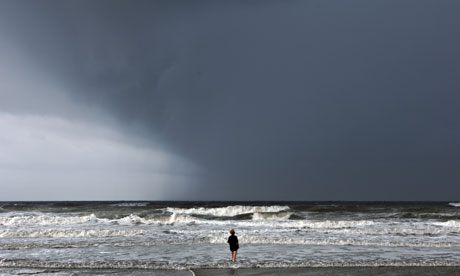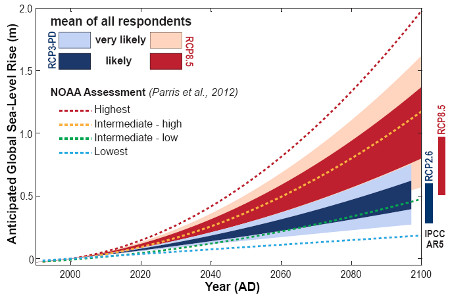by John Abraham, Climate Consensus -- The 97%, The Guardian, December 4, 2013

Sea level rise over the next century depends on future greenhouse gas emissions. Photograph: Jon M Fletcher/AP
It looks like past IPCC predictions of sea level rise were too conservative; things are worse than we thought. That is the takeaway message from a new study out in Quaternary Science Reviews and from updates to the IPCC report itself. The new study, which is also discussed in depth on RealClimate, tries to determine what our sea levels will be in the future. What they found isn't pretty.
Predicting of sea level rise is a challenging business. While we have good information about what has happened in the past, we still have trouble looking into the future. So, what do we know? Well it is clear that sea levels began to rise about 100 years ago. This rise coincided with increasing global temperatures.
What causes sea level to rise? Really three things. First, water expands as it heats. Second, glaciers melt and water flows to the oceans. Third, the large ice caps on Greenland and Antarctica can melt and the liquid water enters the ocean; often the water transfer is added by calving at the ice fronts which result in icebergs that float into the ocean. In the past, much of the sea level rise was related to the first cause (thermal expansion). Now, however, more and more sea level rise is being caused by melting ice.
But this is all the past. What we really want to know is, how much will sea level rise in the future? There are a number of ways to predict the future. First, we can look at the deep past and see how sea level changed with Earth temperature long ago.
A second way to predict the future is through computational models. These models are computer programs which create a virtual-reality of the Earth. These virtual reality models are very useful because they allow scientists to play "what if" scenarios; but, they have their weaknesses as well. One of their weaknesses is that they don't necessarily capture all of the phenomena which cause sea level rise. It is believed by most scientists that the computer programs are too conservative.
How does this all relate to the current study? Well the authors took a different approach. They decided to ask the scientists themselves. What do they think sea level rise will be by 2100 and 2300 under different greenhouse gas scenarios? The authors found 360 sea-level experts through a literature survey. They then worked to find contact information for these scientists and finally, they sent a questionnaire. After receiving 90 expert judgments from 18 countries, the results were tallied. So, what do experts think?
 Sea level rise over the period 2000–2100 for high and low warming scenarios. The ranges show the average numbers given across all the experts. For comparison we see the NOAA projections of December 2012 (dashed lines) and the new IPCC projections (bars on the right).
Sea level rise over the period 2000–2100 for high and low warming scenarios. The ranges show the average numbers given across all the experts. For comparison we see the NOAA projections of December 2012 (dashed lines) and the new IPCC projections (bars on the right).
According to the best case scenario (humans take very aggressive action to reduce greenhouse gases), the experts think sea level rise will likely be about 0.4–0.6 meters (1.3–2.0 feet) by 2100 and 0.6–1.0 meters (2.0–3.3 feet) by 2300. According to the more likely higher emission scenario, the results are 0.7–1.2 meters (2.3–3.9 feet) by 2100 and 2.0–3.0 meters (6.5–9.8 feet) by 2300. These are significantly larger than the predictions set forth in the recently published IPCC AR5 report. They reflect what my colleagues, particularly scientists at NOAA, have been telling me for about three years.
How should we plan for this rise? Some areas can be protected by expensive walling off of ocean water. Other locations simply cannot be saved. Particularly, in areas that have porous subsurfaces, it isn't possible to stop the rising waters. Dealing with the costs of relocation, storm surges, and rising waters will be expensive. This is just another reason why reducing emissions is the best, most cost effective way of adapting to climate change.
How should we plan for this rise? Some areas can be protected by expensive walling off of ocean water. Other locations simply cannot be saved. Particularly, in areas that have porous subsurfaces, it isn't possible to stop the rising waters. Dealing with the costs of relocation, storm surges, and rising waters will be expensive. This is just another reason why reducing emissions is the best, most cost effective way of adapting to climate change.







No comments:
Post a Comment